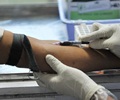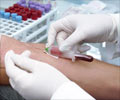Historical trauma could be behind the rise in hepatitis C in Canadian aboriginals, yet another study has confirmed.
More than 100,000 aboriginal children were removed from their families in Canada between 1874 and 1986, it has been estimated. The trauma is still wreaking havoc on the community, it seems - poverty, family disintegration, drug abuse and unprotected sex making the children vulnerable to elevated HIV risk.The Public Health Agency of Canada estimates the prevalence of hepatitis C infection is 0.8 per cent in the general Canadian population, but the disease is seven times more prevalent among aboriginal people than non-aboriginal people.
A Cedar Project study looked at 512 aboriginal people with an average age of 23 living in Vancouver's Downtown Eastside and in Prince George, a forestry and mining town in the northern interior of British Columbia (B.C.)
Of those studied, 286 participants reported injecting drugs while enrolled in the study between September 2003 and April 2005. In this group, 59 per cent, or 170 participants, were infected with hepatitis C when the study began, Prof. Patricia Spittal of the University of British Columbia's school of population and public health and her colleagues reported in the journal Open Medicine.
Among the 199 participants who tested negative for hepatitis C initially, 21 new infections were recorded over an average followup of 11 months. Among participants who reported injection drug use, the researchers estimated 23 per cent would develop hepatitis C.
The hepatitis C virus is spread through contact with infected blood, such as sharing poorly sterilized needles or other contaminated equipment. While it can cause liver damage or cancer, the disease is often not detected in patients for years.
Advertisement
Being female (women were 1.9 times more likely to test positive).
Advertisement
Reusing syringes (2.4 times more likely).
Aboriginal leaders and those who care for people with HIV/AIDS have been concerned about the impact of the HIV and hepatitis C epidemics in cities and rural areas.
The study's authors called for culturally based prevention, treatment and harm-reduction programs that are designed and delivered by aboriginal people, including needle exchanges, wide distribution of clean needles and safe injection sites.
Since the 1980s, Vancouver has been considered a provincial and national epicentre for HIV and hepatitis C. The Cedar Project findings indicate the face of these epidemics is changing to an increasingly aboriginal one, the researchers said.
The Cedar Project is a community based research initiative that addresses hepatitis C and HIV vulnerabilities among young Aboriginal people who use illicit drugs in three cities in British Columbia, Canada. On a global scale, the historical trauma associated with the process of colonizing Indigenous people is commonly considered to be the explanation for the profound health disparities they experience all over the world.
Findings from a 2008 study on at-risk Aboriginal young people in British Columbia had also pointed to alarming patterns of historical trauma, sexual abuse and elevated HIV risk. That study too had been sponsored by the
Dr. Patricia Spittal, the Cedar study’s principal investigator, had noted that one of the most troubling of the team’s findings was the average age of first experience of sexual abuse - it happend even as they turned six.
“Prior to European contact and the residential school system, sexual abuse was rarely found in Aboriginal communities and traditional justice systems dealt harshly with offenders,” said Dr. Spittal.
Chief Mabel Louie of the Stellaten First Nation in Northern B.C. stated “There is an increased interest in exploring traditional methods of child protection and ceremonial rites and obligations to our children and young people. Our culture is medicine. And our kinship systems have been amazingly resilient despite hundreds of years of colonial reality.”
The Cedar data also indicated an increased vulnerability for negative health outcomes among the participants who reported sexual abuse, as compared to participants who did not. Participants who reported sexual abuse were:
2 times more likely to be HIV-positive
2 times more likely to have lived on the streets
2 times more likely to have attempted suicide
1.8 times more likely to have been involved in sexual work
1.8 times more likely to have more than 20 lifetime sexual partners
“This study confirms that sexual abuse is one of the most devastating outcomes of colonization,” said Chief Wayne Christian of the Splatsin Secwepemc Nation. “We witnessed our members return to our communities from residential schools and inflict upon their own children what they learned about control and abuse.
“We have continued to bury this intergenerational cycle of sexual abuse because it’s shameful. We as Chiefs must challenge our own leadership to stand up for our children. We’ve lived in denial for long enough and it’s high time for a response.”
Lou Demerais, Executive Director of Vancouver Native Health Society added: “While the province needs to think outside of the box when it comes to the treatment and healing of our communities, the solutions must come from us. All of the involved ministries can have a real impact and more effectively use existing resources simply by becoming more flexible in their policies and programming.”
Aboriginal young people who use drugs and have a history of incarceration are more likely to exhibit a tendency toward repetition of criminal or antisocial behavior patterns - more so if they were first incarcerated under the age of 17, had ever slept on the streets, been charged with a minor offence, injected drugs, or participated in drug and alcohol treatment, research in Simon Fraser University showed.
The paper recommended that the provincial government “engage with Aboriginal communities in the development and implementation of intensive and holistic services that can address the multiple challenges facing Aboriginal youth in custody to decrease the high rates of recidivism among Aboriginal youth.”
Source-Medindia
GPL














